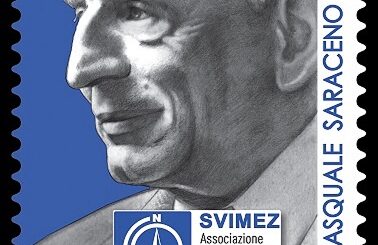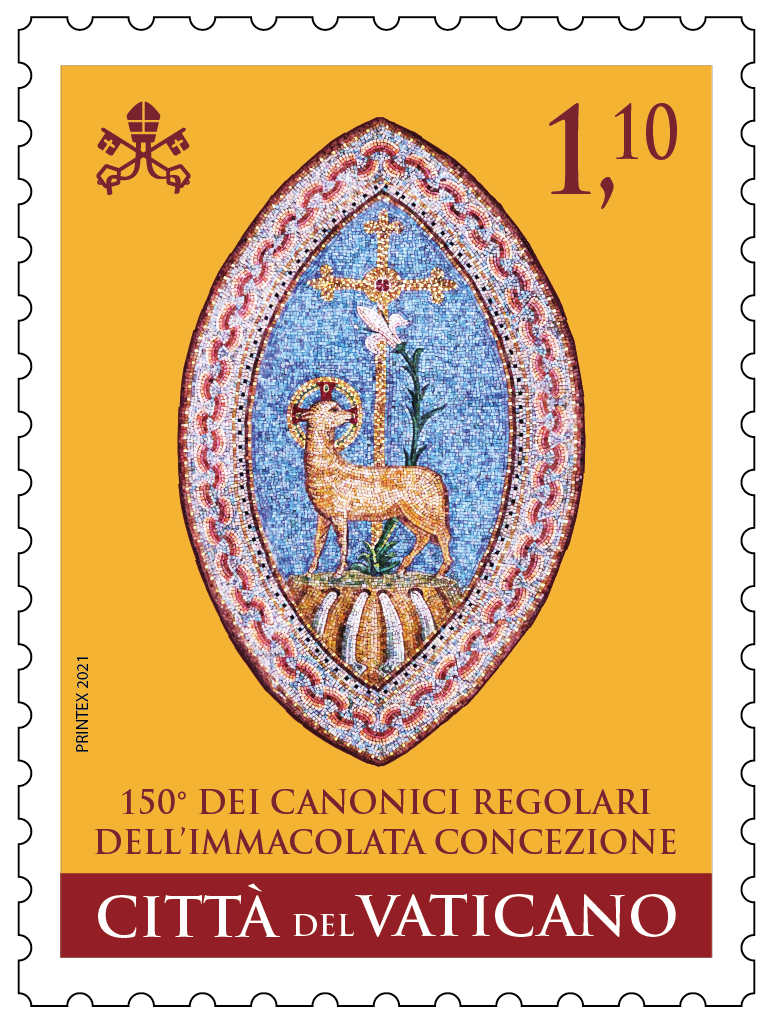POSTE ITALIANE 70^ emissione del 12 Dicembre 2019 di un francobollo dedicato al Porto Franco di Trieste, nel III centenario della istituzione
POSTE ITALIANE 70^ emissione del 12 Dicembre 2019 di un francobollo dedicato al Porto Franco di Trieste, nel III centenario della istituzione

Il Ministero dello Sviluppo ha emesso il 13 dicembre 2019 un francobollo ordinario appartenente alla serie tematica “le Eccellenze del sistema produttivo ed economico” dedicato al Porto Franco di Trieste, nel III centenario della istituzione, relativo al valore della tariffa B, corrispondente ad € 1.10.
- data / date 12 dicembre 2019
- dentellatura / serration 11
- stampa / printing rotocalcografia
- tipo di carta / paper type carta patinata gommata, adesiva
- stampato / printed I.P.Z.S. Roma
- tiratura / edition 500.000
- fogli / sheet 45
- dimensioni / dimension 40 x 30 mm
- costo / price B = € 1,10
- bozzettista/ designer Silvia Isola
- num. catalogo/catalog num. Michel YT UN
Il porto di Trieste è situato a Trieste, a nord del mare Adriatico. È il primo per traffico merci in Italia con 62 milioni di tonnellate annue nel 2017, seguito da quello di Genova.
È suddiviso in cinque aree, corrispondenti ai cinque punti franchi, tre delle quali adibite a fini commerciali:
- Il Punto Franco Vecchio
- Il Punto Franco Nuovo
- Il terminal del legname, detto scalo legnami
le due rimanenti sono utilizzate a scopi industriali:
- Il terminal industriale
- Il terminal petroli che serve l’oleodotto Trieste-Ingolstadt
Storia
Nel 1850 la Società del Lloyd Austriaco commissiona all’architetto danese Christian Hansen il progetto per una sede del nuovo arsenale visto che quello vecchio era stato espropriato a favore della Marina Militare Austriaca. Ora è sede dell’Autorità portuale di Trieste.
Nascita e sviluppo
La storia del porto di Trieste iniziò nel XVIII secolo, a seguito della dichiarazione della libertà di navigazione nell’Adriatico del 1717 e della concessione della patente di porto franco nel 1719 da parte di Carlo VI d’Asburgo, imperatore del Sacro Romano Impero.
Con le patenti del 9 gennaio 1745 e del 27 aprile 1769, Maria Teresa d’Austria confermò la natura di porto franco, ampliandone i privilegi; in particolare, con la seconda ripristinò l’antico privilegio di assenza dei dazi per quanto riguarda i beni di consumo in uscita dalla Carniola e destinati alla città e al suo territorio, e aggiunse simili vantaggi doganali anche per l’importazione di materie prime e l’esportazione di prodotti finiti dalle fabbriche triestine verso le altre provincie austriache.
Con la Pace di Vienna del 1809, il porto passò sotto la dominazione francese per essere riguadagnato al governo austriaco dopo la sconfitta di Napoleone e la Pace di Parigi del 1814. Lo status di porto franco si è conservato fino ad oggi.
Il porto cominciò ad occupare progressivamente un posto sempre più di rilievo nel crocevia tra i trasporti marittimi e via terra che sfruttavano il corridoio del Mare Adriatico.
Nella seconda metà del XIX secolo l’importanza del porto triestino continuò ad aumentare grazie all’arrivo del collegamento ferroviario con Vienna e alla costruzione di nuovi complessi (attualmente indicati come Porto vecchio).
Dopo l’apertura, nel 1869, del Canale di Suez ci si rese conto che il porto di Trieste necessitava di un ulteriore ampliamento che si concluse, dopo diverse fermate, verso la metà degli anni venti.
Gli ampliamenti non si fermarono all’inizio del secolo ma continuarono anche durante gli anni sessanta con l’apertura dell’oleodotto transalpino e nei settanta con il completamento del terminal contenitori.
Ai sensi del Trattato di Parigi (1947), al porto franco di Trieste è riconosciuta l’extraterritorialità: dal 1947 vi si accede passando una dogana, appunto in quanto zona internazionale. Nel 2014 l’Autorità portuale ha presentato uno studio sul punto franco di Trieste e sui suoi vantaggi, rilevando che lo scalo triestino ha il 73% delle agevolazioni in più rispetto agli altri porti.
Il porto oggi
Nell’ambito dei traghetti, il Porto di Trieste possiede la più grande autostrada del mare tra la Turchia e l’Europa operata con dieci traghetti che collegano il porto giuliano a quelli di Istanbul e Mersin. Dal molo VI partono invece altri tre traghetti che collegano Trieste ad Haydarpasa (Istanbul). Per quanto riguarda l’Albania, ogni martedì parte da Trieste un traghetto con destinazione Durazzo.
Per quanto riguarda il traffico container, il porto di Trieste è utilizzato dalle maggiori compagnie mondiali, come Maersk, CMA CGM, MSC, Evergreen, ZIM, Safmarine e Cosco, ed è il secondo porto container in Adriatico dopo Capodistria e prima di Venezia totalizzando nel 2017 la cifra record di 616.156 TEU (pieni all’89%).
Il porto di Trieste possiede inoltre un moderno terminal passeggeri che ha più che raddoppiato il suo traffico fra il 2010 e il 2013 e che nell’ambito della diminuzione del passaggio delle grandi navi a Venezia si propone alle compagnie crocieristiche come porto passeggeri di riferimento per l’Alto Adriatico con collegamenti sia via terra che via mare con la città lagunare. A partire dal 2014, il porto di Trieste è stato inoltre oggetto di crescenti interessamenti e investimenti da parte del governo cinese e di numerose società basate nella Repubblica Popolare, che in esso hanno visto uno scalo importante nel contesto del grande progetto di connettività infrastrutturale della Nuova via della seta.
Al 2019, il porto di Trieste e La Spezia sono gli unici due hub italiani dotati di infrastrutture ferroviarie adeguate per il trasporto intermodale su gomma, con relativo retroporto. La linea ad alta capacità Venezia-Trieste è in fase di studio di fattibilità, ed è alternativa al progetto di velocizzazione della tratta esistente con una riduzione di 30 minuti dei tempi di percorrenza e una spesa di € 1.8 mld.
Se sei interessato all’acquisto di questo francobollo lo puoi acquistare al prezzo di €1.50. Inviami una richiesta alla email: protofilia1@gmail.com

POSTE ITALIANE 70th issue of 12 December 2019 of a stamp dedicated to the Free Port of Trieste, in the III centenary of the institution

On December 13, 2019, the Ministry of Development issued an ordinary stamp belonging to the thematic series “Excellencies of the productive and economic system” dedicated to the Free Port of Trieste, in the third centenary of the institution, relating to the value of tariff B, corresponding to € 1.10
- data / date 12 dicembre 2019
- dentellatura / serration 11
- stampa / printing rotocalcografia
- tipo di carta / paper type carta patinata gommata, adesiva
- stampato / printed I.P.Z.S. Roma
- tiratura / edition 500.000
- fogli / sheet 45
- dimensioni / dimension 40 x 30 mm
- costo / price B = € 1,10
- bozzettista/ designer Silvia Isola
- num. catalogo/catalog num. Michel YT UN
The port of Trieste is located in Trieste, north of the Adriatic Sea. It is the first in Italy for freight traffic with 62 million tons per year in 2017, followed by Genoa.
It is divided into five areas, corresponding to five free points, three of which are used for commercial purposes:
• The Punto Franco Vecchio
• The Punto Franco Nuovo
• The timber terminal, called wood yard
the two remaining are used for industrial purposes:
• The industrial terminal
• The oil terminal that serves the Trieste-Ingolstadt pipeline
History
In 1850 the Austrian Lloyd Society commissioned the Danish architect Christian Hansen the project for a new arsenal building, as the old one had been expropriated in favor of the Austrian Navy. Now it is the seat of the Trieste Port Authority.
Birth and development
The history of the port of Trieste began in the eighteenth century, following the declaration of freedom of navigation in the Adriatic of 1717 and the granting of the license of free port in 1719 by Charles VI of Habsburg, emperor of the Holy Roman Empire.
With the licenses of January 9, 1745 and April 27, 1769, Maria Teresa of Austria confirmed the nature of free port, expanding its privileges; in particular, with the second it restored the ancient privilege of no duties as regards consumer goods leaving the Carniola and destined for the city and its territory, and added similar customs advantages also for the importation of raw materials and materials. export of finished products from the Trieste factories to the other Austrian provinces.
With the Peace of Vienna of 1809, the port came under French domination to be regained by the Austrian government after the defeat of Napoleon and the Peace of Paris of 1814. The status of a free port has been preserved until today.
The port gradually began to occupy an increasingly prominent place at the crossroads between sea and land transport that exploited the Adriatic Sea corridor.
In the second half of the nineteenth century the importance of the Trieste port continued to increase thanks to the arrival of the railway connection with Vienna and the construction of new complexes (currently referred to as Porto vecchio).
After the opening of the Suez Canal in 1869, it was realized that the port of Trieste needed a further expansion that ended, after several stops, in the mid-twenties.
The enlargements did not stop at the beginning of the century but continued even during the sixties with the opening of the transalpine pipeline and in the seventies with the completion of the container terminal.
Under the Treaty of Paris (1947), extraterritoriality is recognized at the free port of Trieste: since 1947 it has been accessed via a customs post, precisely as an international zone. In 2014 the Port Authority presented a study on the free zone of Trieste and its advantages, noting that the Trieste airport has 73% more facilities than other ports.
The port today
As regards ferries, the Port of Trieste has the largest motorway of the sea between Turkey and Europe operated by ten ferries that connect the Julian port with those of Istanbul and Mersin. From the VI pier there are three other ferries that connect Trieste to Haydarpasa (Istanbul). As for Albania, every Tuesday a ferry departs from Trieste with destination Durres.
As regards container traffic, the port of Trieste is used by the major world companies, such as Maersk, CMA CGM, MSC, Evergreen, ZIM, Safmarine and Cosco, and is the second largest container port in the Adriatic after Koper and before Venice totaling in 2017 the record figure of 616.156 TEU (full 89%).
The port of Trieste also has a modern passenger terminal that has more than doubled its traffic between 2010 and 2013 and that as part of the decrease in the passage of large ships to Venice, it is proposed to cruise companies as a reference passenger port for the ‘Upper Adriatic with connections both by land and by sea with the lagoon city. Starting in 2014, the port of Trieste was also subject to growing interest and investments from the Chinese government and numerous companies based in the People’s Republic, which saw it as an important stopover in the context of the great infrastructure connectivity project of the New Silk Road. As of 2019, the ports of Trieste and La Spezia are the only two Italian hubs equipped with adequate railway infrastructures for intermodal road transport, with the associated storage area. The high-capacity Venice-Trieste line is undergoing a feasibility study, and is an alternative to the project to speed up the existing section with a 30-minute reduction in travel times and an expenditure of € 1.8 billion.
If you are interested in buying the stamp you can buy it for € 1.50. Send me a request to the email: protofilia1@gmail.com







